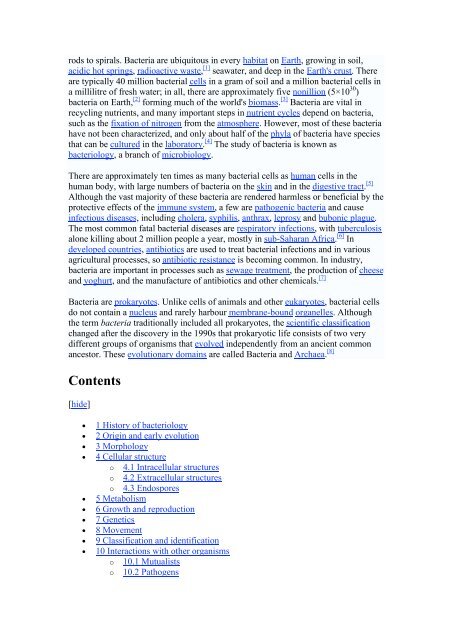Amoeboid - Thierry Karsenti
Amoeboid - Thierry Karsenti
Amoeboid - Thierry Karsenti
Create successful ePaper yourself
Turn your PDF publications into a flip-book with our unique Google optimized e-Paper software.
ods to spirals. Bacteria are ubiquitous in every habitat on Earth, growing in soil,<br />
acidic hot springs, radioactive waste, [1] seawater, and deep in the Earth's crust. There<br />
are typically 40 million bacterial cells in a gram of soil and a million bacterial cells in<br />
a millilitre of fresh water; in all, there are approximately five nonillion (5×10 30 )<br />
bacteria on Earth, [2] forming much of the world's biomass. [3] Bacteria are vital in<br />
recycling nutrients, and many important steps in nutrient cycles depend on bacteria,<br />
such as the fixation of nitrogen from the atmosphere. However, most of these bacteria<br />
have not been characterized, and only about half of the phyla of bacteria have species<br />
that can be cultured in the laboratory. [4] The study of bacteria is known as<br />
bacteriology, a branch of microbiology.<br />
There are approximately ten times as many bacterial cells as human cells in the<br />
human body, with large numbers of bacteria on the skin and in the digestive tract. [5]<br />
Although the vast majority of these bacteria are rendered harmless or beneficial by the<br />
protective effects of the immune system, a few are pathogenic bacteria and cause<br />
infectious diseases, including cholera, syphilis, anthrax, leprosy and bubonic plague.<br />
The most common fatal bacterial diseases are respiratory infections, with tuberculosis<br />
alone killing about 2 million people a year, mostly in sub-Saharan Africa. [6] In<br />
developed countries, antibiotics are used to treat bacterial infections and in various<br />
agricultural processes, so antibiotic resistance is becoming common. In industry,<br />
bacteria are important in processes such as sewage treatment, the production of cheese<br />
and yoghurt, and the manufacture of antibiotics and other chemicals. [7]<br />
Bacteria are prokaryotes. Unlike cells of animals and other eukaryotes, bacterial cells<br />
do not contain a nucleus and rarely harbour membrane-bound organelles. Although<br />
the term bacteria traditionally included all prokaryotes, the scientific classification<br />
changed after the discovery in the 1990s that prokaryotic life consists of two very<br />
different groups of organisms that evolved independently from an ancient common<br />
ancestor. These evolutionary domains are called Bacteria and Archaea. [8]<br />
Contents<br />
[hide]<br />
• 1 History of bacteriology<br />
• 2 Origin and early evolution<br />
• 3 Morphology<br />
• 4 Cellular structure<br />
o 4.1 Intracellular structures<br />
o 4.2 Extracellular structures<br />
o 4.3 Endospores<br />
• 5 Metabolism<br />
• 6 Growth and reproduction<br />
• 7 Genetics<br />
• 8 Movement<br />
• 9 Classification and identification<br />
• 10 Interactions with other organisms<br />
o 10.1 Mutualists<br />
o 10.2 Pathogens


